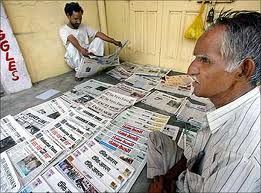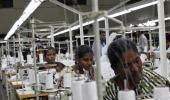 Can things get more miserable for India’s Rs 83,000-crore (Rs 830-billion) media and entertainment industry?
Can things get more miserable for India’s Rs 83,000-crore (Rs 830-billion) media and entertainment industry?
From 10-12 per cent earlier, adspend growth is today crawling at less than seven per cent.
To rub it in, the broadcast regulator is insisting on premature implementation of a rule to cap advertising time on TV.
The battered rupee and rising prices have meant a more than 30 per cent rise in newsprint costs and a similar one in royalty payouts to foreign partners.
The increase in newsprint price alone is enough to wipe out the 5 to 15 per cent profit after tax that most publishers make.
Much of this explains the hectic action in some of India’s biggest newsrooms.
In August, the Rs 2,400-crore (Rs 24-billion) Network18, which owns brands such as CNBC-TV18 and CNN-IBN let go of 350 people, going by media reports.
Another 150 across its various businesses could be getting pink slips soon, say insiders. Even as we write senior managers continue to resign.
EY and Mercer have been part of a right-sizing exercise at the broadcast firm and the chopping is far from over, says one insider.
According to one estimate, the company has a head count of 9,000 that needs to be cut by 30 per cent.
Whether this happens by letting go of people or by selling business units (such as Infomedia) is not clear.
The merger of the group with large parts of Eenadu’s TV business was funded in 2012 by Independent Media Trust, controlled by Mukesh Ambani’s Reliance Industries.
It owns most of the company that Raghav Bahl set up in 1997.
As the new owner demands a return to profitability, some of this was expected. All attempts to get in touch with Network18 were futile.
What Network 18 is struggling with are familiar woes for others in the industry. Media behemoth Anandabazar Patrika group has also put its magazine, Businessworld, on the block.
According to a top official of ABP, a deal could materialise by the end of the year, but if it doesn’t work out then shutting down the magazine could be the only option.
Another media group, Outlook, too recently cancelled licensing arrangements it had with the foreign publishers of Geo, Marie Claire and People.
Salaries to the staff at Outlook and Outlook Money, among its other titles, have been consistently delayed for over a year now.
The decision of the Rajan Raheja Group, which owns Hathway Cable and The Outlook Group, to get out of the licensing arrangement with the foreign titles was strategic, says one insider.
The idea is to focus on its own magazines which it has invested in for almost 18 years instead of titles where dollar payments on royalty have risen 30-40 per cent.
The buzz on the street is that the group will carry out more rationalising exercises in its bid to bring back profitability to its magazine unit, which has been in the red for some time now senior sources within the group confirmed most of these developments.
“There is no panic-like situation. Salaries have not been cut. Only finances have been reorganised,” clarifies another insider brushing aside the talk of a big corporate house buying the magazine business.
Rumours about Open, a news magazine from the RP-Sanjiv Goenka, are also flying thick and fast.
The four-year-old brand created a buzz by breaking the story about the Radia tapes.
But it is far from breaking even.
Will it be cutting its 90,000-odd print run to save newsprint costs?
R Rajmohan, publisher of Open, dismisses the idea.
“We have just started direct distribution this January and that has helped us increase newsstand sales and penetration.
“There is no way we can pull back.
As a company with one title, what we need is to increase the number of titles (brands). There is no downsizing on the cards,” says he.
Bucking the trend
Times Television Network is one of the few firms with happy news.
Romedy Now, its English movie channel revolving around love and laughter, was launched last week.
However, Sunil Lulla, managing director and CEO, reckons that the industry is in for a painful period.
“There are very few companies that will meet the targets in their business plan this calendar or see any growth over 2012.
“Margins are under significant pressure and it would be smart to be cautious,” he says. Rahul Kansal, executive president, Bennett, Coleman & Co, and Lulla’s colleague in the publishing segment of the Rs 6,700-crore (Rs 67-billion) Times Group, agrees.
“In July, we were cautiously pessimistic, now we are actively so.
“The first and second quarters of this year were pretty good.
“But we have begun to see a distinct change in sentiment in the last 3-4 weeks,” says he.
There are other positive voices.
“Most large companies are well-capitalised and backed by cash-rich people, so I don’t see an issue there,” says one investment banker with a large firm.
“I am not so negative on media, unlike other sectors such as capital goods and infrastructure, which are badly impacted. So, compared to them, media, which is more consumption driven, is alright,” says Salil Pitale, executive director, investment banking, Axis Capital.
The correlation between the growth in media and the economy is incredibly strong.
One investment banker reckons that the media usually grows at 1.5 times the growth rate of the economy.
So when the economy was growing at 8 per cent, adspends were growing at 12-13 per cent. Now that it has slowed to 5 per cent, adspends have slowed to below 7.
This is because as consumer spending slows, every category from automobile and real estate to telecom and financial services substantially drops adspends.
This is hurting the balance sheets of all media firms, some more than others.
For instance, the general entertainment channels and films remain largely unaffected.
However the news industry -- both print and TV -- is facing the brunt of the poor sentiment.
It is completely unprepared for this.
For almost a decade now, news organisations have been net hirers and salaries have risen continuously.
Now, they are reacting in ways that their counterparts in the developed world have for years.
Cover price increases or page cuts that were unheard of in the competitive Indian market are coming into vogue.
The Hindu has been raising its prices steadily for the last one year.
In Delhi, it is now priced at Rs 8, up from Rs 6 earlier.
Ditto for Kolkata.
In Kerala, its newspaper prices have increased from Rs 4 to Rs 5.
It has even taken the price of its school editions to Rs 3 from Rs 1.
The Hindu is also cutting and changing page counts across different editions and supplements in a bid to cut costs.
Arun Anant, CEO, Kasturi & Sons, the publishers of The Hindu, expects this to have a 1-2 per cent impact on the company’s Rs 1,100-crore (Rs 11-billion) topline.
The other response is a push towards efficiency by pruning fixed costs or businesses that are not performing.
That means people lose their jobs.
At Network18, for instance, a bulk of the jobs to go were in editorial and technology since the company is trying to create a common newsroom that feeds the digital, print and TV brands.
“What you are seeing in the industry is right-sizing, not downsizing,” says I Venkat, director, Eenadu.
Is it the economy?
And that brings us to the question, is this just the economy? Many of the analysts and bankers reckon that some of it is the industry’s profligacy coming back to haunt.
For example, Network18’s expansion had overleveraged the company seriously — a point that was routinely dismissed by the management when it was on an acquisition spree.
Take the Rs 2,000-crore (Rs 20-billion) news broadcasting segment, for instance, which is likely to see dozens of channels shutting shop soon.
To compound the mistakes the industry has made is the poorly-timed regulation on ad time.
News broadcasting in India is overcrowded with 135 channels -- many of them started by people with funds of suspect origin.
Hyper-competition has led to falling standards and ad time being stretched to 20-30 minutes for every hour of programming.
This twisted market was hit with the 12-minute cap in March this year.
The industry has been pleading with the regulators to put off the cap until the completion of digitisation in 2014.
Once that happens, carriage fees, currently at 30 per cent of costs for most news broadcasters, will go down substantially while pay revenues could go up from 10 per cent to 20-25 per cent.
This will allow news broadcasters to cut ad time.
Currently, broadcasters are trying to make up for cuts in ad time by pushing up ad rates, without much effect.
From last April to this August, Media Content and Communications Services India, which owns ABP News and other channels, has increased rates by 30 per cent.
It has not been easy since advertisers are unwilling to commit increases at this moment.
“As things stand, we run the risk of our revenues going down by half,” says Ashok Venkatramani, CEO, MCCS.
He points out that 80 per cent of a news broadcaster’s costs -- salaries, carriage and operating expenses -- are fixed.
So it has very little to cut from.
What it can do is delay recruitment or investment in hardware, but ‘that is not a long-term solution,’ he points out.
The bad news is that there don’t seem to be any -- from the government, the opposition or the media industry -- in this market.












 © 2025
© 2025